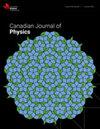重力中的各向同性杜尔加帕尔IV流体球
IF 1
4区 物理与天体物理
Q3 PHYSICS, MULTIDISCIPLINARY
引用次数: 0
摘要
我们分析了一个考虑Durgapal IV度规的各向同性无荷流体球模型[M.C.]J.杜加帕尔。A <b>15<2637(1982)]。在这项工作中,我们研究了尺度参数k对局部物质分布的影响。
在这里,我们选择了观测值为质量=(1.29±0.05)M⊙,半径= 8.831 _0.09 ^{+}0.09{ km的致密恒星候选者SMC X-}1。分别对结果进行分析和图形化分析。对于较小的k值,我们得到刚性(或硬)状态方程(EoS)。本文在背景度规\gamma _ {\mu\nu}存在的情况下,求解了修正的爱因斯坦场方程。由于这个恒定的曲率背景,密度和压力项通过添加一个额外的项来修改,这影响了EoS。对于r \ll k,背景德西特时空约化为闵可夫斯基形式,耦合消失。我们讨论了我们得到的解决方案的某些物理量,如密度、各向同性压力、声速、压力-密度梯度、致密性和表面红移,以声称我们模型的物理可行性。
通过修正的TOV方程,我们的模型清楚地满足了所有的能量条件、因果关系条件和动力平衡。最后,我们可以得出结论,我们提出的模型在物理上是真实的,并且表现良好。本文章由计算机程序翻译,如有差异,请以英文原文为准。
Isotropic Durgapal IV fluid sphere in bigravity
We analyze an isotropic uncharged fluid sphere model within bigravity considering the Durgapal IV metric [M.C. Durgapal, J. Phys. A 15 2637 (1982)]. In this work, we investigate the effects of the scale parameter k on the local matter distribution.
Here, we have chosen the compact star candidate SMC X-1 with observed values of mass =(1.29 ± 0.05)M⊙ and radius = 8.831_{-0.09}^{+0.09} km. respectively, to analyze our results analytically as well as graphically. For smaller values of k, we get the stiff (or hard) equation of state (EoS). Here we solve the modified Einstein's field equations in presence of the background metric \gamma_{\mu \nu}. Due to this constant curvature background, the density and pressure terms are modified by adding an extra term, which affects the EoS. For r \ll k, the background de Sitter space-time reduces into Minkowski form and the coupling vanishes. We discuss certain physical quantities of our obtained solution such as density, isotropic pressure, sound speed, pressure-density gradients, compactness, and surface redshift to claim the physical viability of our model.
It is found that our model clearly satisfies all the energy conditions, the causality condition, and the dynamical equilibrium via modified TOV equation. Finally, we can conclude that our proposed model is physically realistic and well-behaved.
求助全文
通过发布文献求助,成功后即可免费获取论文全文。
去求助
来源期刊

Canadian Journal of Physics
物理-物理:综合
CiteScore
2.30
自引率
8.30%
发文量
65
审稿时长
1.7 months
期刊介绍:
The Canadian Journal of Physics publishes research articles, rapid communications, and review articles that report significant advances in research in physics, including atomic and molecular physics; condensed matter; elementary particles and fields; nuclear physics; gases, fluid dynamics, and plasmas; electromagnetism and optics; mathematical physics; interdisciplinary, classical, and applied physics; relativity and cosmology; physics education research; statistical mechanics and thermodynamics; quantum physics and quantum computing; gravitation and string theory; biophysics; aeronomy and space physics; and astrophysics.
 求助内容:
求助内容: 应助结果提醒方式:
应助结果提醒方式:


